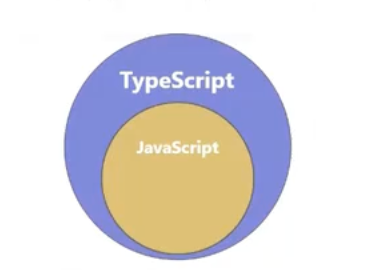TypeScript介绍
2024-10-31
什么是TypeScript
微软开发的。
TypeScript是JavaScript的一个超集,支持ES6标准,可以编译成纯JavaScript运行在任何浏览器上。适用于大型项目。

为什么需要TS
JS地位变得重要,代码量变多,但是JS出生简陋,有许多困扰:
- 不清不楚的数据类型
如果其他人给你数据,但是你不知道数据类型,可能就会错误使用:
let welcome = 'hello'
welcome() //报错,welcome is not a function
- JS不会汇报逻辑错误
比如以下代码,偶数部分的逻辑是永远不可能进入的:
const str = Date.now() % 2 ? '奇数' : '偶数'
if (str !== '奇数'){
alert('hello')
} else if (str === '偶数'){
alert('world')
}
- 访问不存在属性时不会报错
- 低级的拼写错误不会报错
静态类型检查
代码运行前检查,发现代码的错误或不合理之处,减少运行异常出现的概率。
简言之,把运行时的错误前置。
但是,这会造成TS的代码量比JS的大很多。不过在维护方面,TS远胜于JS。
如何编译TS
需要把.ts编译成.js
命令行编译
npm i typescript -g
安装完后,全局出现一个新命令tsc,即typescript compiler。
tsc index //.ts可以省略
编译后,出现一个.js文件。
自动化编译
初始化:
tsc —init
多了一个文件叫tsconfig.json。
监视项目:
tsc —watch
如果希望不出错时不编译,可以在tsconfig.json中解开注释:
"noEmitOnError": true,
还可以通过webpack进行编译。
类型声明
每个变量/参数/函数返回值都需要通过冒号来声明类型。
let a: string = 'Hello World';
let b: number = 10;
let c: boolean = true;
let d: "hello" // 字面量类型,只能赋值为 'hello'
a = 9; // Error: Type '9' is not assignable to type 'string'.
a = false; // Error: Type 'false' is not assignable to type 'string'.
a = 'Hello'; // OK
b = 99; // OK
c = false; // OK
function count(x: number, y: number): number {
return x + y;
}
let result = count(1, 2);
console.log(result); // 3
count(1); // Error: Expected 2 arguments, but got 1.
d = 'hell'; // Error: Type '"hell"' is not assignable to type '"hello"'.
类型推断
// 类型推断
let d = -99; // 类型推断为 number
d = 'hello'; // 因为 d 已经被推断为 number 类型,所以这里会报错
类型总览
JavaScript的类型总览:
- string
- number
- boolean
- null
- undefined
- biginit
- symbol
- object
备注:其中object包含:Array, Function, Date, Error 等......
TypeScript的类型总览:
- 上述所有JavaScript类型
- 六个新类型
① any
② unknown
③ never
④ void
⑤ tuple
⑥ enum - 两个自定义类型的方式
① type
② interface
注意:
在 Javascript 中的这些内置构造函数: Number String Boolean,它们用于创建对应的包装对象,在日常开发时很少使用,在 TypeScript 中也是同理,所以在 TypeScript 中进行类型声明时,通常都是用小写的 number、string、boolean。
包装对象 vs 原始类型
string是原始类型,String是包装对象,我们通常用的是原始类型。
// 类型总览
let str1: string; // TS官方推荐的写法
str1 = 'Hello World';
str1 = new String('hello'); // 错误。不能把一个String对象赋值给一个string类型的变量
let str2: String;
str2 = 'hello';
str2 = new String('hello'); // 正确。String对象可以赋值给String类型的变量
typeof(str1); // string
typeof(str2); // object
常用类型
any
任意类型。放弃变量的类型检查。
可以显式声明和隐式声明:
// 常用数据类型
let p: any; // 显式any
p = 10;
p = 'hello';
p = true;
let q; // 隐式any
q = 10;
q = 10;
q = 'hello';
q = true;
any的坑:any类型的值可以赋给任何数据类型
let q; // 隐式any
q = 10;
let x: string;
x = q; // 不会报错,因为 q 是 any 类型
unknown
可以理解为一个类型安全的any,适用于不确定数据的具体类型。
unknown和any不一样,因为不会踩any的坑,即不能赋值给任何数据类型。
let a: unknown;
a = 99;
a = false;
a = 'hello';
let x: string;
x = a; // 报错。不能将类型“unknown”分配给类型“string”
如何让ts放心的把unknown类型的值赋给其他类型的变量呢?
// 第一种:if判断
if (typeof a === 'string') {
x = a;
}
// 第二种:类型断言的第一种写法
x = a as string;
// 第三种:类型断言的第二种写法
x = <string>a;
unknown也不能使用任何方法,any则相反:
let str1: string;
str1 = 'Hello World';
str1.toUpperCase();
let str2: any;
str2 = 'Hello TypeScript';
str2.toUpperCase();
let str3: unknown;
str3 = 'Hello TypeScript';
str3.toUpperCase(); // 报错。unknown不能调用string类型的方法
never
never用来限制函数的返回值,让函数不返回任何值。注意:一般函数至少会返回undefined,除非抛出错误。
function demo(): never{
throw new Error('程序运行异常!'); // 函数会抛出异常,不会有返回值;正常函数至少会返回undefined
}
void
和never类似,也是用于函数的返回值。区别是void可以接受undefined。
// void可以接受的“空”值:undefined
function logMessage(msg:string): void {
console.log(msg);
}
function logMessage2(msg:string): void {
console.log(msg);
return;
}
function logMessage3(msg:string): void {
console.log(msg);
return undefined;
}
object
小object和大Object一般不用
因为太宽泛了。
// object 类型
let a: object; //a能存储的类型是【非原始类型】
let b: Object; //b能存储的类型是可以调用到Object上所有方法的类型
// a能存储的类型
a = {};
a = {name: 'lison'};
a = function () {};
a = new String('aaa');
class Person {}
a = new Person();
// a不能存储的类型
a = 1;
a = 'aaa';
a = true;
a = undefined;
a = null;
// b能存储的类型
b = {};
b = {name: 'lison'};
b = function () {};
b = new String('aaa');
b = new Person();
b = 1;
b = 'aaa';
b = true;
// b不能存储的类型
b = undefined;
b = null;
怎么声明对象?
let person: {name: string, age?: number}; //?代表age属性是可选的
person = {name: 'Jack', age: 32};
声明对象追加属性
let person: {
name: string
age?: number //?代表age属性是可选的
[key: string]: any //含义:除了name和age属性外,还可以有其他任意属性,属性名是字符串类型,属性值是任意类型
};
person = {name: 'Jack', age: 32, gender: '男', height: 180};
声明函数类型
let count: (a: number, b: number) => number;
count = (a, b) => {
return a + b;
}
声明数组类型
let arr: string[]; //第一种方式
let arr2: Array<string>; //第二种方式,泛型方式
arr = ['a', 'b', 'c'];
arr2 = ['a', 'b', 'c'];
tuple
元组(tuple)是一种特殊的数组类型,它限定了数组的长度和每个元素的类型。
// tuple是一种特殊的数组,它限定了数组的长度和每个元素的类型
let arr1: [string, number];
let arr2: [string, boolean?];
let arr3: [number, ...string[]]; //含义:你可以有任意多个string类型的元素,但是第一个元素必顼是number类型
arr1 = ['Hello', 10];
arr2 = ['Hello'];
arr3 = [10, 'Hello', 'World'];
enum
枚举(enum)可以定义一组命名常量,作用是增强代码的可读性,让代码更好维护。
数字枚举
enum Direction {
Up,
Down,
Left,
Right
}
console.log(Direction); // Direction是一个对象 { '0': 'Up', '1': 'Down', '2': 'Left', '3': 'Right', Up: 0, Down: 1, Left: 2, Right: 3 }
console.log(Direction.Up); // 0
console.log(Direction.Down); // 1
console.log(Direction.Left); // 2
console.log(Direction.Right); // 3
console.log(Direction[0]); // Up
console.log(Direction[1]); // Down
console.log(Direction[2]); // Left
console.log(Direction[3]); // Right
function walk(data:Direction){
if (data === Direction.Up){ //避免直接使用字符串,避免写错
console.log("向【上】走");
} else if (data === Direction.Down){
console.log("向【下】走");
} else if (data === Direction.Left){
console.log("向【左】走");
} else if (data === Direction.Right){
console.log("向【右】走");
} else {
console.log("未知");
}
}
walk(Direction.Up); // 向【上】走
字符串枚举
enum Direction {
Up = "up",
Down = "down",
Left = "left",
Right = "right"
}
常量枚举
把枚举包在一个常量const中。
作用:ts编译成js后,只输出使用的枚举属性,比如Up,其他属性不输出,简化js代码。
const enum Direction {
Up,
Down,
Left,
Right
}
console.log(Direction.Up);
type
能为任意多种数据类型创建别名。
联合类型(“或”)
type Status = number | string;
type Gender = "男" | "女";
function printStatus(status: Status): void {
console.log(status);
}
printStatus(200); // 200
function printGender(gender: Gender): void {
console.log(gender);
}
printGender("不男不女"); // 报错
交叉类型(“并且”)
// 面积
type Area = {
width: number;
height: number;
}
// 地址
type Address = {
city: string;
country: string;
room: number;
}
type House = Area & Address;
const house: House = {
width: 100,
height: 200,
city: 'Beijing',
country: 'China',
room: 505
}
一种例外情况
type定义的函数,返回void的定义是无效的。
type LogFunc = () => void;
const f1: LogFunc = () => {
// return undefined;
return 999; // 没有报错,因为没做限制;如果做限制,箭头函数默认返回值可能不是undefined,会报错,就不能使用箭头函数。
}
可查看TypeScript视频教学具体了解情况,TypeScript官网上也有详细的案例解析。
类class
class Person {
name: string;
age: number;
constructor(name: string, age: number) {
this.name = name;
this.age = age;
}
speak() {
console.log(`My name is ${this.name} and I am ${this.age} years old.`);
}
}
const p1 = new Person('Alice', 30);
console.log(p1);
p1.speak();
class Student extends Person {
grade: string;
constructor(name: string, age: number, grade: string) {
super(name, age);
this.grade = grade;
}
study() {
console.log(`${this.name} is studying.`);
}
override speak() { // 重写父类方法
console.log(`My name is ${this.name} and I am ${this.age} years old. I am in grade ${this.grade}.`);
}
}
const s1 = new Student('Bob', 20, '高三');
console.log(s1);
s1.study();
s1.speak();
属性修饰符
如果有C和Java基础,很容易理解:public, protected, private, readonly:

public修饰符
在类的外部、内部、子类都能访问到,默认情况下(不加public),就是public的修饰符。
class Person {
public name: string;
public age: number;
constructor(name: string, age: number) {
this.name = name;
this.age = age;
}
speak() {
console.log(`My name is ${this.name} and I am ${this.age} years old.`); //在类的内部使用name
}
}
class Student extends Person {
study() {
console.log(`${this.name} is studying.`); //在子类中使用name
}
}
const p1 = new Person('Alice', 20);
console.log(p1.name); //在类的外部使用name
属性的简写形式
class Person {
constructor(public name: string, public age: number) {}
}
protected修饰符
只能在类内部、子类访问。
class Person {
constructor(
protected name: string,
protected age: number
) {}
protected getDetails() {
return `${this.name} is ${this.age} years old`;
}
introduce(){
console.log(this.getDetails())
}
}
const p1 = new Person('John', 30);
p1.name; // 不能访问,属于外部访问。
p1.age; // 不能访问,属于外部访问。
p1.getDetails(); // 不能访问,属于外部访问。
p1.introduce(); // 可以访问
class Student extends Person {
study(){
this.introduce(); // introduce可以访问
console.log(`${this.name} is studying`); // protected name可以访问
}
}
private修饰符
只能在类内部访问。
class Person {
constructor(
public name: string,
public age: number,
private IDcard: string
) {}
private getPrivateInfo(){
return `身份证号码:${this.IDcard}`
}
getInfo(){
return `姓名:${this.name},年龄:${this.age}`
}
getFullInfo(){
return this.getInfo() + ',' + this.getPrivateInfo()
}
}
const p1 = new Person('张三', 18, '123456789')
p1.name; // '张三'
p1.age; // 18
p1.IDcard; // 错误,无法访问
p1.getInfo(); // '姓名:张三,年龄:18'
p1.getPriavteInfo(); // 错误,无法访问
p1.getFullInfo(); // '姓名:张三,年龄:18,身份证号码:123456789'
readonly修饰符
只读属性,一旦实例确定值,不可更改。
class Person {
constructor(
public name: string,
public readonly age: number,
) {}
}
const p1 = new Person('Mark', 39);
console.log(p1); // Person { name: 'Mark', age: 39 }
p1.age = 22; // Error: Cannot assign to 'age' because it is a read-only property.
抽象类
无法被实例化的类。即不能new出一个对象。
抽象类的意义是别人可以继承它。
abstract class Package {
//构造方法
constructor(public weight: number) {
}
//抽象方法
abstract calculate(): void;
//具体方法
printPackage() {
console.log(`Package weight: ${this.weight}, cost: ${this.calculate()}`);
}
}
const p1 = new Package(); // Error: Cannot create an instance of an abstract class.
class StandardPackage extends Package {
constructor(
weight: number,
public unitPrice: number
) {super(weight);}
calculate() {
return this.weight * this.unitPrice;
}
}
const s1 = new StandardPackage(10, 2);
s1.printPackage(); // Package weight: 10, cost: 20
interface (接口)
定义结构的一种方式。
针对类、对象、函数等规定一种契约。
只能定义格式,不能包含任何实现。
接口定义类结构
// PersonInterface 接口
interface PersonInterface {
name: string;
age: number;
speak(n: number): void;
}
class Person implements PersonInterface {
constructor(public name: string, public age: number) {}
speak(n: number): void {
for (let i = 0; i < n; i++) {
console.log('Hello, my name is ' + this.name);
console.log('I am ' + this.age + ' years old');
}
}
}
接口定义对象结构
接口可以当数据类型用。
interface UserInterface{
name: string;
readonly gender: string; // 只读属性
age?: number; // 可选属性
run: (n: number) => void;
}
const user: UserInterface = {
name: 'zhangsan',
gender: 'male',
age: 18,
run(n) {
console.log(`I am running ${n}m`);
}
}
接口定义函数结构
interface CountInterface {
(a: number, b: number): number;
}
const count: CountInterface = (a, b) => a + b;
接口之间的继承
类似类(class)的继承。
interface PersonInterface {
name: string;
age: number;
}
interface StudentInterface extends PersonInterface {
grade: number; //年级
}
接口的自动合并
同名的接口会自动合并。
interface PersonInterface {
name: string;
age: number;
}
interface PersonInterface {
gender: string;
}
const person: PersonInterface = {
name: 'John Doe',
age: 30,
gender: "male"
};
何时使用接口?
- 定义对象的格式。描述数据模型,api相应格式,配置对象。
- 类的契约。指定一个类需要的属性和方法。
- 自动合并。扩展第三方库可能会用到,用在大型项目比较多。
一些相似的概念
interface和type的区别
相同点:interface和type都可以定义对象结构,两者在许多场景都可以互换。
不同点:
interface: 更专注于定义对象和类的结构,支持继承、合并;
type:可以定义类型别名、联合类型、交叉类型,不支持继承、合并。
interface与抽象类的区别
相同点:都用于定义一个类的格式(应该遵循的契约)
不同点:
interface: 只能描述结构,不能有任何实现代码。一个类可以有多个接口。
抽象类:既可以包括抽象方法,也可以包括具体方法。一个类只能继承一个抽象类。
泛型
定义函数、类或接口时,允许未指定的类型。
使用时,才指定具体的类型。
加个T标签就可以实现,以下是泛型函数举例:
泛型函数
function logData<T>(data: T){
console.log(data);
}
logData<number>(1);
logData<string>('Hello');
泛型可以有多个
function logData<T, U>(data1: T, data2: U) {
Date.now() % 2 ? console.log(data1) : console.log(data2);
}
logData<number, boolean>(1, true);
logData<string, number>('Hello', 2);
泛型接口
interface PersonInterface <T> {
name: string;
age: number;
extraInfo: T;
}
let p: PersonInterface<string> = {
name: 'John',
age: 30,
extraInfo: 'Hello'
}
类型声明文件
类型声明文件是 TypeScript 中的一种特殊文件,通常以.d.ts作为扩展名。它的主要作用是为现有的 JavaScript 代码提供类型信息,使得 TypeScript 能够在使用这些 JavaScript 库或模块时进行类型检查和提示。
简言之,主要用于ts文件引入js文件造成的数据类型丢失。
js本身不定义数据类型,如果要在ts文件内引入demo.js,还需要创建一个demo.d.ts,在该文件里面声明数据类型即可,这样浏览器就不会报错。
这个文件通常保存在@types文件夹。
